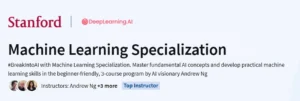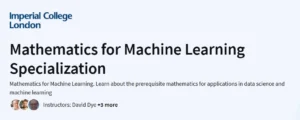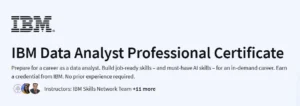What will you learn in A Practical Guide to Machine Learning with Python Course
Implement core machine learning algorithms in Python: linear regression, logistic regression, decision trees, random forests, SVMs, K-NN, and ensemble methods
Perform exploratory data analysis and preprocessing: handling missing values, feature scaling, one-hot encoding, and dimensionality reduction (PCA, clustering)
Validate and tune models using train/test splits, k-fold cross-validation, and hyperparameter search (grid/randomized search)
Build end-to-end predictive pipelines: data ingestion, model training, evaluation metrics, and deployment considerations
Program Overview
Introduction & Setup
⏳ 30 minutes
Topics: Course objectives, Python ML ecosystem (NumPy, pandas, scikit-learn), Jupyter notebook setup
Hands-on: Configure your environment and load a sample dataset
Exploratory Data Analysis
⏳ 2 hours
Topics: DataFrame operations, summary statistics, visualization with Matplotlib/Seaborn
Hands-on: Profile a dataset—identify distributions, outliers, and correlations
Data Preprocessing
⏳ 2 hours
Topics: Handling missing data, encoding categorical features, feature scaling (StandardScaler, MinMaxScaler)
Hands-on: Clean and transform data for modeling, build a reusable preprocessing pipeline
Unsupervised Learning & Feature Engineering
⏳ 2 hours
Topics: K-Means clustering, PCA for dimensionality reduction, feature construction
Hands-on: Cluster customers for segmentation and reduce feature space with PCA
Model Evaluation & Validation
⏳ 1.5 hours
Topics: Train/test split, k-fold cross-validation, evaluation metrics (MAE, MSE, accuracy, ROC AUC)
Hands-on: Compare multiple models on a benchmark dataset using cross-validation
Regression Algorithms
⏳ 3 hours
Topics: Linear regression, regularized regression (Ridge, Lasso), tree-based regressors
Hands-on: Predict housing prices; tune hyperparameters with GridSearchCV
Classification Algorithms
⏳ 3 hours
Topics: Logistic regression, K-NN, SVM, decision trees, random forests, gradient boosting
Hands-on: Build a classification pipeline for a medical-diagnosis dataset; evaluate with confusion matrices and ROC curves
Advanced Topics & Ensemble Methods
⏳ 2 hours
Topics: Bagging, boosting (AdaBoost, XGBoost), stacking, handling imbalanced classes with SMOTE
Hands-on: Improve model performance through ensemble stacking and balance techniques
Model Deployment & Next Steps
⏳ 1 hour
Topics: Saving models with joblib, basic Flask API for serving predictions, tips for production readiness
Hands-on: Wrap a trained model in a simple REST endpoint for real-time inference
Get certificate
Job Outlook
Data Analyst / ML Engineer: $85,000–$130,000/year — leverage ML to drive data-driven decisions in tech, finance, healthcare
Data Scientist: $95,000–$150,000/year — build and deploy predictive models to solve business problems
Machine Learning Engineer: $100,000–$160,000/year — productionize ML pipelines and scale machine learning solutions
Explore More Learning Paths
Enhance your practical machine learning expertise by building, training, and deploying intelligent models using Python. These related courses will help you advance from foundational ML concepts to real-world production systems and cloud-based AI solutions.
Related Courses
Applied Machine Learning in Python Course — Learn how to implement core ML algorithms, evaluate model performance, and work with Python’s most powerful data libraries.
Advanced Machine Learning on Google Cloud Specialization Course — Master cloud-based ML workflows and scalable model deployment using Google Cloud tools and TensorFlow.
Production Machine Learning Systems Course — Understand how to transition models from research to production, ensuring reliability, scalability, and performance in real-world environments.
Related Reading
What Is Data Management? — Discover how organized and high-quality data serves as the foundation for building accurate, efficient, and reliable machine learning systems.
Specification: A Practical Guide to Machine Learning with Python Course
|
FAQs
- No prior Quarkus experience required; beginner-friendly.
- Covers Quarkus CLI, Maven plugin, and project setup.
- Introduces microservice concepts with hands-on projects.
- Gradually builds REST, WebSocket, and GraphQL services.
- Emphasizes practical understanding of fault-tolerant microservices.
- Develop CRUD REST endpoints using JAX-RS.
- Build real-time chat microservices with WebSockets.
- Expose GraphQL APIs with SmallRye integration.
- Implement database persistence using Panache ORM and JDBC.
- Integrate fault tolerance with retries, circuit breakers, and health checks.
- Emphasizes microservice architecture and Quarkus features.
- Covers REST, WebSockets, GraphQL, and persistence.
- Does not cover Docker, Kubernetes, or advanced security protocols.
- Introduces reactive vs. imperative persistence briefly.
- Focuses on building deployable and resilient microservices quickly.
- Gain hands-on experience building resilient microservices.
- Learn REST, GraphQL, WebSocket, and database integration.
- Understand fault tolerance, retries, and circuit breakers.
- Prepare for job roles in cloud-native and backend development.
- Develop a capstone project for your portfolio.
- Hands-on exercises for each Quarkus module.
- Create REST endpoints, integrate APIs, and build WebSocket services.
- Expose GraphQL queries and mutations with real objects.
- Implement database persistence using Panache ORM.
- Capstone project combines all modules into a complete microservice application.





